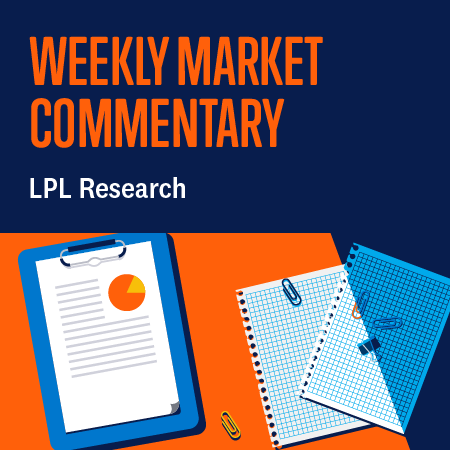The Federal Reserve (Fed) often uses the Jackson Hole Symposium to announce tweaks in policy. Other central bank leaders are also worth watching as investors try to perceive where rates will be in the coming months. In this piece, we discuss some of the opportunities and risks we see in the markets and the economy following the central banker confab. We close the piece with investment implications.
Volatility has returned right on cue as U.S. equity markets continue to pull back from overbought levels. The recent jump in interest rates has proven to be too much too fast for stocks to absorb, especially for the heavyweight and longer-duration technology sector. Deteriorating economic conditions in China and weak seasonal trends have been additional factors behind the selling pressure. However, don’t panic, pullbacks are completely normal within a bull market. With volatility comes opportunity, and as valuations reset, overbought conditions recede, and support is found, we believe a buying opportunity back into this bull market will present itself over the coming months.
It’s different this time. The four (or five) most dangerous words in investing. We’ll take the risk and use those words here as we break down the recent decision by credit rating agency Fitch to downgrade U.S. government debt to its second-highest rating, AA+ (note that several countries in Europe, including Denmark, Germany, Netherlands, and Switzerland enjoy AAA ratings, as do Johnson and Johnson (JNJ) and Microsoft (MSFT)). We compare the potential market impact of this decision to what markets experienced in 2011 when S&P issued its U.S. debt downgrade.
Earnings season is mostly behind us with about 85% of S&P 500 companies having reported second quarter results. The high level results aren’t particularly impressive, but if we peel back the onion, the numbers are encouraging. Results and guidance probably haven’t been good enough for stocks to add to recent gains, but they have been good enough, in our view, to end the earnings recession and limit the magnitude of any potential pullback. Here we provide some takeaways from this earnings season.
The economy is doing better than expected, and the markets are responding accordingly. In this piece, we discuss some of the factors that cause us to think the Federal Reserve (Fed) hiked for the last time in this cycle as inflation is receding and the outlook for the consumer looks cloudy. We close the piece with investment implications.
The first half of the year probably didn’t go the way many fixed income investors had hoped, particularly after the historically awful year last year. It wasn’t a horrible start—more in line with recent years—but expectations were high this year, with many calling 2023 the year for fixed income. But the themes that negatively impacted fixed income investors last year have carried over into this year as well—namely inflation and the Federal Reserve (Fed). While many of us thought the Fed would likely be done raising rates at this point, given the still high (but falling) inflation levels, it looks like the Fed isn’t quite done just yet. Our base case is the Fed will raise rates again this week (and possibly one more time this year) but is close to the end of its rate hiking campaign. As we point out in our recent Midyear Outlook 2023: The Path Toward Stability, a Fed pause has been good news for fixed income. And since we know it’s not how you start but how you finish, once the Fed is done, it could mean the year for fixed income is only postponed and not canceled.
Earnings season is upon us as some banks and a small handful of other blue chip companies have already reported results for their quarters ending June 30. The results on the surface probably won’t offer much to write home about given consensus estimates imply a 7% year-over-year decline in S&P 500 earnings per share. However, the key question is always what’s priced in, which at least offers an opportunity for markets to react positively, though our best guess is we get the typical upside surprises and guidance reductions, giving this rally a convenient excuse to take a breather.
The long dormant capital markets have recently begun showing signs of interest from institutional investors and deal makers anxious to bring companies to market. While activity remains muted at best, expectations are focused on 2024, when there is a prevailing consensus that the Federal Reserve (Fed) will be finished with its rate hike campaign, and that economic conditions will be resilient enough to underpin a strong capital markets environment. Given the country's unique characteristics in nurturing innovation and technological leadership, the role of capital markets is crucial in maintaining hegemony. That Apple's market capitalization at the close of the second quarter crossed over $3 trillion, exemplifies the country's dominance and the role of innovative experimentation.
We know it’s old news at this point, but on June 8, 2023, the S&P 500 entered a new bull market. After such a strong rally off the October lows, this young bull probably needs a breather. A look at the charts suggests this market may be due for a pause. Bull markets are not linear. However, the impending end of the Federal Reserve (Fed) rate-hiking campaign, and the economy’s and corporate America’s resilience, help make the bull case that steers LPL Research toward a neutral, rather than negative, equities view from a tactical asset allocation perspective.
As the economy is likely downshifting, investors should take heed that the Federal Reserve’s (Fed) current stance is eerily similar to early 2007. During that time, the Fed held a tightening bias since they believed the housing market was stabilizing, the economy would continue to expand, and inflation risks remained. Clearly, their expectations were not met as the economy soon fell into recession. That’s not suggesting another 2008 is coming, but rather highlights how fast the economic environment can change.
The Federal Reserve (Fed) meets this week where it is largely expected to not raise short term interest rates for the first time in 15 months. However, Fed messaging has been all over the place in recent weeks. While some Fed officials continue to advocate for additional rate hikes, others want to be more patient. So, according to current market pricing anyway, the Fed is expected to skip the June meeting before hiking again in July which could mark the starting point for an extended pause. It can be very confusing to markets at times. And throw in the glut of Treasury issuance expected to come to the market and the Fed is likely going to continue to stay in the news for the foreseeable future. The good news? We agree with markets that the end of the rate hiking campaign is near, which has historically been a good thing for core bond investors.
Stocks have had a nice run, but at higher prices, the bar for further gains gets higher. We have recently made the case in this publication that there are a lot of reasons to expect the market to go higher between now and year end. But with stocks at higher valuations, high-quality bonds offering attractive yields, an S&P 500 Index with concentrated leadership facing technical resistance at 4,300, and an elevated risk of a late-2023 recession, we think it makes sense to be a bit careful here. Importantly, though, neutral is not bearish.


